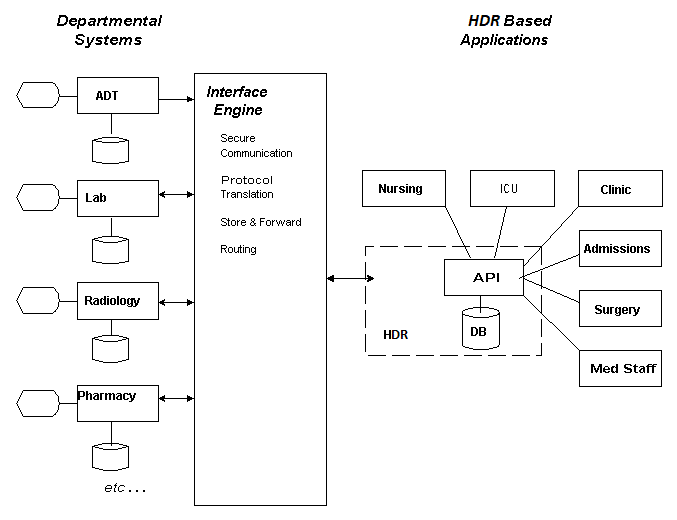1 HDR Components
- Services
- Java APIs
- Integrating the Healthcare Enterprise (IHE)
- Messaging Interface
- Concurrent Program Service for Scheduling Jobs
- Enterprise Terminology Services
- Profile Option Services
- Audit Services
- RIM Service
Figure 1-1 Example of a typical HDR solution:

Oracle Healthcare Data Repository (HDR) includes solution components critical to the creation of applications that support the management and provision of care in diverse healthcare settings. The associated functionality includes content from administrative, clinical and financial healthcare domain areas. This Programmer's Guide complements Oracle Healthcare Data Repository API documentation.
HL7 Reference Information Model (RIM) Version 3 provides a model of the healthcare domain, including compatibility with XML messaging. By focusing on standard interfaces, HDR makes it easy to build applications using industry standard tools (thanks to J2EE) and to interoperate with other healthcare systems (thanks to HL7).
The Java API is used by programmers to develop healthcare applications. The messaging interface is used to exchange data with other computing systems. HDR-based applications typically use both systems.
At an architectural level, HDR has three key interfaces with other software:
- The Java Application Programming Interface (API): The Java API lets customers write applications using HDR services. Because services are exposed as Remote and Local EJBs, client code can either be co-located on the middle-tier with HDR, or reside on its own tier, communicating via Java RMI. See "Java APIs".
- HL7 version 3 Based Messages: HDR supports the transmission of well formed HL7 version 3 messages that conform with the Oracle Healthcare Data Repository HL7 Version 3 Messaging Conformance Specification. This interface supports interoperability between HDR based applications and third party applications. See "Messaging Interface".
- Services: The service interfaces are a standards based collection of Enterprise Javabeans (EJBs), each of which provides a functional service. Its architecture is driven by two complementary standards: Java 2 Platform, Enterprise Edition (J2EE) and HL7 Version 3. J2EE provides industry standard interfaces and protocols for the plumbing of the system. See "Services".